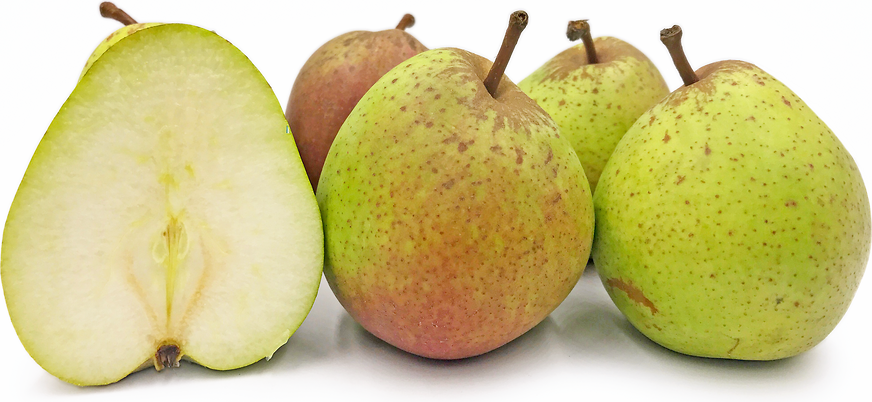


Fin de Siecle Pears
Estimated Inventory, lb : 0
Description/Taste
Fin de Siecle pears are medium to large in size, averaging 6-7 centimeters in diameter and 6-8 centimeters in height and are oblong to conical in shape with a slight tapering at the stem end. The thin skin has a light green base that transforms to yellow when ripe and is covered in brown russeting, prominent lenticels, and some rose blushing. The white flesh is fine-grained, creamy, and moist with a small central core containing tiny black-brown seeds. When ripe, Fin de Siecle pears are very juicy with a buttery, melting consistency and are exceptionally sweet with notes of almond and rose.
Seasons/Availability
Fin de Siecle pears are available in the fall through winter.
Current Facts
Fin de Siecle pears, botanically classified as Pyrus communis, are a relatively old and rare variety that are members of the Rosaceae family along with apples and peaches. Originally from Belgium, Fin de Siecle pears are believed to have been grown from a seed of the souvenir de lydie pear and are favored as a fresh eating variety for their buttery texture and sweet flavor.
Nutritional Value
Fin de Siecle pears contain some potassium, fiber, calcium, and vitamin C.
Applications
Fin de Siecle pears are best suited for raw applications as their creamy and juicy flesh cannot withstand high heat applications. They are considered a dessert variety and are meant to be enjoyed fresh, out-of-hand. Fin de Siecle pears can be sliced and mixed into leafy salads, pasta salads, and fruit salads. They can also be sliced over yogurt, cereal, oatmeal, cakes, tarts, crumbles, and served over vanilla ice cream. Fin de Siecle pears compliment nuts such as pecans and walnuts, balsamic vinegar, arugula, kale, radicchio, spinach, parmesan, strawberries, pomegranate seeds, basil, mint, and meats such as pork, chicken, and beef. They will only keep for a couple of days when stored at room temperature.
Ethnic/Cultural Info
The phrase “fin de siècle” means “end of the century,” or “turn of the century” in French. It is a reference to when this pear was first grown and marketed, around the turn of the twentieth century.
Geography/History
Fin de Siecle pears are native to Belgium, and the exact history is largely unknown. These pears were believed to have been raised by Daras de Naghin in Antwerp, Belgium in 1899 and were named one year later in 1900. Today Fin de Siecle pears are rare and are only available in limited quantities at farmers markets, specialty grocers, and private orchards in Europe.
Recipe Ideas
Recipes that include Fin de Siecle Pears. One
| Running to the Kitchen |
|
Pear, Bacon and Brie Grilled Cheese |
| Dinner at the Zoo |
|
Pear Custard Pie |
Podcasts




